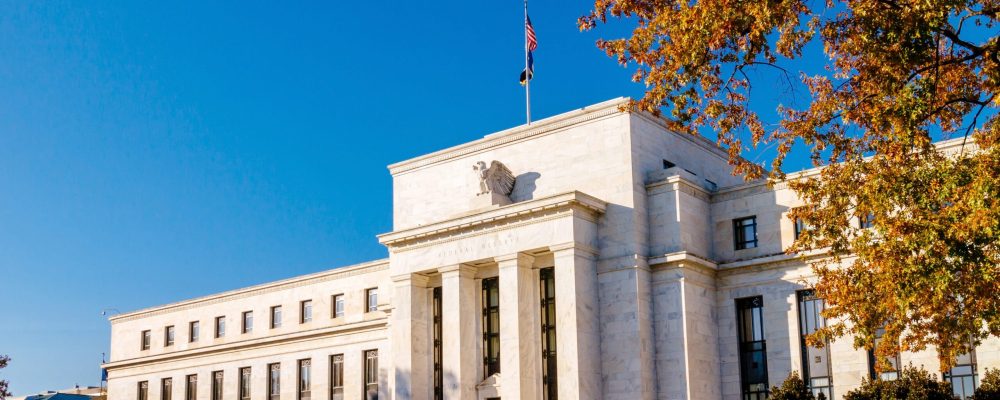
The information provided is based on the published date.
Key takeaways
- For the third meeting in a row, the Fed raised their interest rate target by 0.75%
- Powell signaled that more rate hikes would likely be needed in the coming months to quell inflation
- We expect the Fed will keep hiking until there is very clear evidence inflation is decelerating
On Wednesday September 21, the Federal Reserve concluded their two day meeting. For the third meeting in a row, the Fed raised their interest rate target by 0.75%. Cumulatively they have now raised rates by a full 3% so far in 2022, with no obvious end in sight. Here’s what happened at that meeting and what it means for you.
The Fed hikes interest rates by .75% for third consecutive increase
It is important to put this Fed move into context. The speed at which the Fed is hiking interest rates is unprecedented. The Fed has hiked rates by 3% in 2022, which is already the most in a calendar year since the Fed started targeting interest rates in 1982. Prior to now, the Fed had only hiked by 0.75% in a single meeting once in its history. Now they have done it three meetings in a row.
All of this shows us that the Fed is laser focused on getting inflation back under control. In his post-meeting press conference, Fed Chair Jerome Powell strongly emphasized that he was committed to price stability, even at the expense of causing a recession. “We have to get inflation behind us. I wish there were a painless way to do that. There isn’t.”
More rate hikes are likely in the coming months
Powell signaled that more rate hikes would likely be needed in the coming months to quell inflation. It seems the rest of his Fed colleagues agree. Along with this meeting, the Fed released the quarterly Summary of Economic Projections which includes the so-called “dot plot.” The dot plot is where each member of the Fed’s Open Markets Committee (FOMC) makes their own estimate of where the Fed’s target rate should be set at various future dates, assuming that member’s personal economic forecast comes to fruition. While the dot plot doesn’t necessarily do a good job of predicting what will actually happen with interest rates, it does give us a sense of how different Committee members are thinking about future policy right now.
The dots indicated that almost all FOMC members expect either 1% or 1.25% worth of additional hikes in 2022. That would bring the Fed’s target rate to either 4% or 4.25%. In 2023 members are more split, but the midpoint suggests an additional 0.25% or 0.5% of hikes in 2023. In 2024, most members see rates declining but only slightly.
Again, each member’s “dot” is predicated on their own economic forecast actually being realized. In reality, actual economic events will be what dictates Fed policy. However what this does show us is that the Fed’s predilection is to keep rates high for at least a couple years into the future, even if inflation returns to around 2%. This is probably because the Fed wants to be sure that once inflation returns to normal that it actually stays low. One take away we have from this is that a pause in rate hikes could very easily happen, but actual rate cuts would require a much bigger change in economic conditions.
Why not hike by a full 1%?
Prior to this meeting there was some talk that the Fed could hike by a full percentage point. In the end they “only” hiked by 0.75%. If inflation is such a problem, why not be even more aggressive?
Powell didn’t give a firm answer on this question, but the most likely reason is that there are some nascent signs that the economy is slowing. Powell specifically cited slower household spending, weaker housing market activity, and a slowing of business investment. If all of these elements continue on the current trend, there’s a good chance that inflation has already peaked.
Of course, these early signs of waning inflation could reverse. Or inflation could move lower but not as quickly as the Fed wants. In either case we should expect the Fed to keep hiking until they are confident inflation is subsiding. However, if inflation were to start to decline meaningfully, the Fed may want to pause rate hikes early in 2023. If they had hiked 100bps now, it would have increased the risk that they overdo it and harm the economy unnecessarily.
The Fed’s resolve is critical
No matter what happens, Chair Powell wants the public to understand how committed the Fed is to price stability. In a recent speech, Powell discussed his views on why inflation got so out of control in the 1970’s. Specifically, he cited the fact that the Fed several times cut interest rates before inflation had actually stabilized. As a result, inflation reignited. Worse, this eroded the public’s confidence in price stability. Economists generally believe that when the public expects high inflation that makes companies more willing to raise prices and workers more likely to demand wage increases. In other words, it partially becomes self-fulfilling.
Powell forcefully stated that he won’t let that happen now. We expect the Fed will keep hiking until there is very clear evidence inflation is decelerating. Once that starts, the Fed will probably keep interest rates high until inflation has reverted all the way to 2% or is very close. Again, we saw this kind of pattern in the dot plot, with most members preferring to see rates stay elevated into 2024.
What does this mean for you?
Coming into this meeting, the bond market was anticipating that the Fed would raise interest rates another 1.5% between now and the middle of 2023. That is roughly in-line with what the dot plot showed, and thus there wasn’t a huge reaction in the bond market. In other words, today’s bond yields and prices had already adjusted to the Fed’s plans. We think bond yields are looking pretty attractive for long-term investors. The Bloomberg Aggregate, which tracks the broad U.S. high quality bond market, yields 4.44% right now. Yield is a measure of a bond’s expected return if held to maturity. That 4.44% figure is the highest since 2009. In other words, the expected return on a broad bond portfolio is the highest it has been in 13 years.
For stocks, the Fed’s aggressive fight against inflation certainly has risks. It is for this reason that we’d say the chance of a recession in 2023 and 2024 is higher than usual. However with the broad U.S. market down almost 20% year-to-date, some kind of recession is probably already reflected in prices. Indeed our research indicates that when markets have already fallen 20%, the next 3, 6 and 12-months all usually produce above-average returns.
Our view all year has been that stocks will perform well once inflation gets under control and we get some clarity about the pace of Fed hikes. Unfortunately neither has happened just yet. But we are seeing increasing evidence that inflation pressure should be subsiding. Earlier we mentioned slower housing market activity and consumer spending, but also job growth appears to have slowed, gas prices and other raw material prices have fallen. In addition, we’ve heard reports from companies that inventories are building up, most recently in Federal Express’ earnings report. Usually higher inventories precede price cuts. As Chair Powell said, fighting inflation isn’t “painless” but given how much pain is already priced in, we are still quite confident in holding our equity allocation.
Tom Graff, Chief Investment Officer
Facet Wealth, Inc. (“Facet”) is an SEC registered investment adviser headquartered in Baltimore, Maryland. This is not an offer to sell securities or the solicitation of an offer to purchase securities. This is not investment, financial, legal, or tax advice. Past performance is not a guarantee of future performance.


